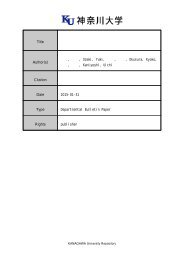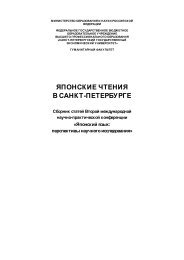to Learners with Special Educational Needs
e-textbook SEN
e-textbook SEN
Create successful ePaper yourself
Turn your PDF publications into a flip-book with our unique Google optimized e-Paper software.
Pokrivčáková, S. et al. (2015). Teaching Foreign Languages <strong>to</strong> <strong>Learners</strong> <strong>with</strong> <strong>Special</strong> <strong>Educational</strong> <strong>Needs</strong>:<br />
e-textbook for foreign language teachers. Nitra: Constantine the Philosopher University. 128 p.<br />
ISBN 978-80-558-0941-0<br />
7 Drama as a multisensory approach <strong>to</strong> include SEN learners<br />
in an EFL classroom<br />
Šárka Dohnalová<br />
DOI: 10.17846/SEN.2015.101-110<br />
Objectives<br />
The objective of this chapter is <strong>to</strong> introduce drama and structuring drama work as a<br />
multisensory approach that integrates more than only linguistic intelligence (Gardner, 1999),<br />
which is not the strenth of SEN learners, namely dyslexic learners. Structured drama is a special<br />
type of method or holistic planning of teaching the EFL subject content in a meaningful context.<br />
As this is a complex method the aim of this chapter is <strong>to</strong> briefly introduce the theoretical<br />
background of drama in EFL as well as <strong>to</strong> introduce one structured drama lesson <strong>to</strong> demonstrate<br />
some of the possibilities of structuring EFL content in a way that is suitable for SEN children<br />
incorporating psychomo<strong>to</strong>ric, affective, and cognitive aims; various learning strategies as well as<br />
various intelligences.<br />
SEN learners need <strong>to</strong> acquire English as a foreign language in situated, experiential and<br />
holistic learning, which might, however, be a challenge for the language teachers, therefore, a<br />
complete drama structure based on a simplified reader is an integral part of the chapter <strong>to</strong><br />
demonstrate structuring drama work and give the target audience, i.e. teachers of English as a<br />
foreign language, a model lesson <strong>with</strong> practical teaching tips, which can be used for their own<br />
creative work in EFL<br />
Think and do:<br />
Before learning the facts from the chapter try <strong>to</strong> summarise your own knowledge of<br />
drama in EFL on a poster.<br />
Work as the whole group. Put the word “DRAMA” in the middle of the poster. Then<br />
write any associations that come in your heads.<br />
1. Terminology and literature review<br />
Drama came in<strong>to</strong> being in 1924 at the university in Evans<strong>to</strong>n (Illinois) almost at the same<br />
time as the project method (Machková, 2012), a project usually uses only the content of a<br />
subject, however, drama works <strong>with</strong> the interpersonal relationships and human interaction. The<br />
main drama activity is in the world of „as if“, i.e. the world of fiction and imagination, using<br />
various techniques and conventions originally created for ac<strong>to</strong>rs´ training. As there are many<br />
techniques and conventions, each student can find some that suit him or her and their way of<br />
learning as everyone is different and everyone is good at something else (Armstrong, 2011).<br />
Drama as well as project teaching requests friendly atmosphere in the classroom; structured<br />
drama is a kind of project incorporating drama techniques, where the necessary condition of a<br />
successful implementation of the method is the social climate of the classroom and the feeling of<br />
safety and no threat <strong>to</strong> the learner (Kra<strong>to</strong>chvílová, 2009), which is crucial for making SEN<br />
children successful.<br />
Drama in ELT is a quite recent phenomenon as Almond (2005) suggests on page 9 where he<br />
states that in the 1980s drama specialists still felt that drama needed <strong>to</strong> be demystified and was<br />
almost impossible <strong>to</strong> define due <strong>to</strong> intangibility and immeasurability while <strong>to</strong>day most teachers<br />
know what drama is and recognise its value in ELT. The methods and conventions of drama in<br />
education are based upon the holistic, experiential, and cooperative learning and are based<br />
primarily on the humanistic and constructivist conception of education. It is a complex teaching<br />
101






